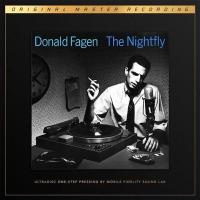Donald Fagen's "The Nightfly" — Mobile Fidelity Does the Digital One-Step
Even the threat of nuclear war didn't interfere with the young man's make-out fantasies in dad's bomb shelter! "I.G.Y."'s optimism is best expressed today as irony. Listening to it reminded me of the "loose affiliation of millionaires and billionaires" that Paul Simon sang about with equal optimism and enthusiasm on Graceland's "Boy in the Bubble", that today sounds positively sinister.
The title tune expressed on the cover shows Fagen flying solo as the WJAZ all-night D.J. back when being a disc jockey was so cool. The microphone is the iconic RCA 77DX, while the turntable is a radio station transcription special (I know, I should know the 'table and arm models cold, but I don't) capable of playing 16 2/3 rpm records. He's got a Sonny Rollins Contemporary jacket next to the old turntable and a Riverside on the platter, but never mind! It's just an album cover.
In the grooves of the record, great jazz, rock and studio cats bring to life the young man's fantasies and even though this was recorded at a time when an over reliance on cheesy synthesizers ruined many an otherwise fine record, Fagen and producer Gary Katz avoided that trap. The production and arrangements for the most part sound remarkably undated and pleasingly contemporary, led by Larry Carlton's sinewy guitar leads. The cast of bass characters is stellar: Anthony Jackson, Chuck Rainey, Abe Laboriel, Marcus Miller and Will Lee! Every seat in the various ensembles is occupied by musical luminaries. Yes, jazz was always in the Steely Dan rock mix, even direct lifts like the opening to "Rikki Don't Lose the Number", but the closer, "Walk Between Raindrops" unabashedly swings—as does the cover of Leiber and Stoller's "Ruby Baby"! Musical history has been kind to this exercise in musical and technical perfection, but more so to the music.
Truth be told, I loved the music but hated the sound of this record when it came out. It sounded "digital"—hashy, gritty and artificial. Is that really what drums, especially cymbals, sound like? It sounded like a drum machine then and it still does to me. I have read that Fagen and producer Gary Katz recorded to both a Studer 24 track and to 3M's 32 track and 4 track recorders and thought the digital far superior. I wonder if Fagen still does? So many musicians at the time were enticed but today have second thoughts.
That said, there are certain excellent qualities to the digital here, especially the transient attack precision and black backgrounds but it all still sounds synthesized to me, including and especially the horns. Your reaction may differ. The 3M system had a 50.4kHz sampling rate and 16 bit depth, though at the time 16 bit converters did not exist. The machine had a 12 bit converter plus 4 "borrowed" from an 8 bit converter and no digital output. I don't have the original Bob Ludwig mastered vinyl but no doubt it was cut from an analog master made directly from the digital two track master. No doubt that's what Mobile Fidelity used for its 1/2 speed mastered version cut using "the original master tape" (MFSL 1-120) released in 1983.
Mobile Fidelity does not identify the source used here. Did they have access to the original 3M digital master tape and a machine with which to play it back? If so did they use the machine's analog output or somehow "jury rig" a digital output (not likely)? I don't know.
Spreading the album out to four 45rpm sides definitely makes it easier to cut and track and no doubt the EQ has been tastefully and moderately manipulated to produce a more pleasing balance than on the earlier Mo-Fi LP cut. Of course the people who say "you can buy this 'on digital'" are missing the point: however you buy The Nightfly, it had to have come from the tape machine in the analog domain. To produce the digital version required another conversion back to digital. Not here though. It's "pure analog" (from digital) and whatever Krieg Wunderlich used as a source, and however he's manipulated the equalization, this should be the best sounding The Nightfly you've ever heard, though the objectionable qualities (to some ears) remain, as they should. They are part of the production. You'll love the sparkly bells on "Green Flower Street", that's for sure. The packaging is similar to Mo-Fi's previous "one step" releases—"classy" in a kind of black and funereal kind of way. I wonder what Donald Fagen thinks of all of this now sold out release (limited to 6000 copies)? One thing's for sure: he's probably made more money from this release of 6000 copies than from a million streams.



